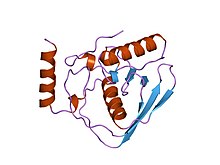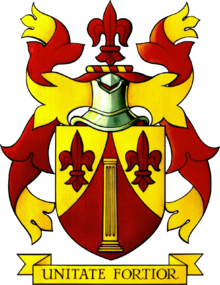펩타이드변형효소
Peptide deformylase| 펩타이드변형효소 | |||||||||
|---|---|---|---|---|---|---|---|---|---|
 대장균펩타이드변형효소구조 | |||||||||
| 식별자 | |||||||||
| EC 번호 | 3.5.1.88 | ||||||||
| 데이터베이스 | |||||||||
| 인텐츠 | IntEnz 뷰 | ||||||||
| 브렌다 | 브렌다 엔트리 | ||||||||
| ExPASy | NiceZyme 뷰 | ||||||||
| 케그 | KEGG 엔트리 | ||||||||
| 메타사이크 | 대사 경로 | ||||||||
| 프라이머리 | 프로필 | ||||||||
| PDB 구조 | RCSB PDB PDBe PDBum | ||||||||
| 진 온톨로지 | AmiGO / QuickGO | ||||||||
| |||||||||
효소학에서 펩타이드 변형효소(EC 3.5.1.88)는 화학 반응을 촉매하는 효소이다.
- HO2 + 포르밀-L-메티오닐펩타이드 { \ 메티오닐펩타이드 + 포름산염
따라서 이 효소의 2가지 기질은 포르밀-L-메티오닐펩타이드와 HO이며2, 그 2가지 생성물은 포르말산염과 메티오닐펩타이드이다.
이 효소는 펩타이드 결합 이외의 탄소-질소 결합, 특히 선형 아미드에 작용하는 가수분해효소군에 속합니다.이 효소 클래스의 계통명은 포르밀-L-메티오닐펩타이드 아미도히드로라아제이다.
구조 연구
2007년 말 현재 이 등급의 효소에 대해 해결된 구조는 34개이며 PDB 가입 코드 1IX1, 1LM4, 1LM6, 1LME, 1LQW, 1LQY, 1LRU, 1LRY, 1N5N, 1Q1Y, 1S172이다.
「 」를 참조해 주세요.
레퍼런스
- Adams JM (1968). "On the release of the formyl group from nascent protein". J. Mol. Biol. 33 (3): 571–89. doi:10.1016/0022-2836(68)90307-0. PMID 4973445.
- Mazel D, Pochet S, Marliere P (1994). "Genetic characterization of polypeptide deformylase, a distinctive enzyme of eubacterial translation". EMBO J. 13 (4): 914–23. doi:10.1002/j.1460-2075.1994.tb06335.x. PMC 394892. PMID 8112305.
- Chan MK, Gong W, Rajagopalan PT, Hao B, Tsai CM, Pei D (1997). "Crystal structure of the Escherichia coli peptide deformylase". Biochemistry. 36 (45): 13904–9. doi:10.1021/bi9711543. PMID 9374869.
- Becker A, Schlichting I, Kabsch W, Schultz S, Wagner AF (1998). "Structure of peptide deformylase and identification of the substrate binding site". J. Biol. Chem. 273 (19): 11413–6. doi:10.1074/jbc.273.19.11413. PMID 9565550.
- Becker A, Schlichting I, Kabsch W, Groche D, Schultz S, Wagner AF (1998). "Iron center, substrate recognition and mechanism of peptide deformylase". Nat. Struct. Biol. 5 (12): 1053–8. doi:10.1038/4162. PMID 9846875. S2CID 40528211.
- Rajagopalan PT, Yu XC, Pei D (1997). "Peptide deformylase: a new type of mononuclear iron protein". J. Am. Chem. Soc. 119 (50): 12418–12419. doi:10.1021/ja9734096.
- Groche D, Becker A, Schlichting I, Kabsch W, Schultz S, Wagner AF (1998). "Isolation and crystallization of functionally competent Escherichia coli peptide deformylase forms containing either iron or nickel in the active site". Biochem. Biophys. Res. Commun. 246 (2): 342–6. doi:10.1006/bbrc.1998.8616. PMID 9610360.
- Rajagopalan PT, Grimme S, Pei D (2000). "Characterization of cobalt(II)-substituted peptide deformylase: function of the metal ion and the catalytic residue Glu-133". Biochemistry. 39 (4): 779–90. doi:10.1021/bi9919899. PMID 10651644.
- Hu YJ, Wei Y, Zhou Y, Rajagopalan PT, Pei D (1999). "Determination of substrate specificity for peptide deformylase through the screening of a combinatorial peptide library". Biochemistry. 38 (2): 643–50. doi:10.1021/bi9820412. PMID 9888804.
- Ragusa S, Mouchet P, Lazennec C, Dive V, Meinnel T (1999). "Substrate recognition and selectivity of peptide deformylase Similarities and differences with metzincins and thermolysin". J. Mol. Biol. 289 (5): 1445–57. doi:10.1006/jmbi.1999.2832. PMID 10373378.
- Giglione C, Pierre M, Meinnel T (2000). "Peptide deformylase as a target for new generation, broad spectrum antimicrobial agents". Mol. Microbiol. 36 (6): 1197–205. doi:10.1046/j.1365-2958.2000.01908.x. PMID 10931273. S2CID 23289620.
- Pei D (2001). "Peptide deformylase: a target for novel antibiotics?". Emerging Therapeutic Targets. 5 (1): 23–40. doi:10.1517/14728222.5.1.23. PMID 15992166. S2CID 11385977.




